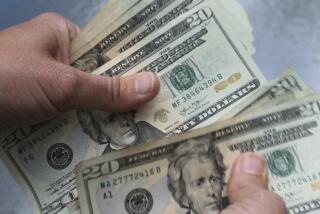Riding Along on the Plastic : Credit card debt soars, yet companies continue to put cards into the hands of credit risks
- Share via
American households are taking on credit card debt at an unprecedented pace, but economists aren’t sure this necessarily signals danger ahead. Elliott Platt of Donaldson, Lufkin & Jenrette Securities Corp. in New York notes that a major reason for the higher debt could simply be that consumers are using their cards in places where checks or cash used to be the norm, like doctors’ offices and supermarkets. Other economists, however, point to the recent big jump in credit card delinquencies and the steep rise in personal bankruptcies as causes for concern.
One thing few dispute is that the highly competitive credit card business can too eagerly put plastic into the hands of dubious credit risks. Literally billions of credit card solicitations are mailed each year, many “preapproved,” meaning detailed financial information isn’t requested. The card companies know from experience that 2% to 3% of their card holders will be unable to meet their payments. Who makes up for those losses? Those who pay their credit card bills do, through interest rate charges that tend to be far higher than those of other loans.
David Hale, chief economist for Kemper Financial Services Inc. in Chicago, doubts that a credit card debacle would bring on a major economic crisis. The main victims, he said, would be lower-income people who had piled up debt well beyond their means to repay it. But there’s also abundant anecdotal evidence that middle-class Americans in increasing numbers are yielding to the temptation to get in over their heads with their credit cards.
In October, consumer credit--excluding mortgage and home equity loans--topped $1 trillion for the first time. Relative to disposable income, consumer credit is now at an all-time high. Consumer spending drives the economy. But consumer debt can also be a drag on economic activity. Right now the share of disposable household income committed to paying off debt is about 17%. That’s approaching the 18.5% figure of 1989--a year in which the nation fell into recession. Something to remember as the debts mount.
More to Read
Inside the business of entertainment
The Wide Shot brings you news, analysis and insights on everything from streaming wars to production — and what it all means for the future.
You may occasionally receive promotional content from the Los Angeles Times.










